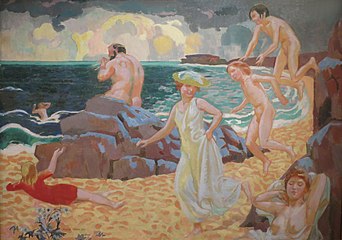Maurice Denis
| Maurice Denis | |
|---|---|
 Foto: Henri Manuel | |
| Personlig information | |
| Født | Maurice Amédée Eugène Denis 25. november 1870 Granville, Frankrig |
| Død | 13. november 1943 (72 år) hôpital Cochin, Frankrig |
| Dødsårsag | Påkørsel |
| Gravsted | cimetière ancien de Saint-Germain-en-Laye |
| Far | Constant Eugène Denis |
| Ægtefæller | Elisabeth Graterolle (1922), Marthe Meurier (1893-1919) |
| Børn | Bernadette Denis, Jean Gabriël, Madeleine Dinès, François Denis, Noëlle Maurice-Denis Boulet, Anne-Marie Poncet-Denis |
| Uddannelse og virke | |
| Uddannelsessted | École nationale supérieure des Beaux-Arts, Académie Julian (fra 1888), Lycée Condorcet (1882-1887) |
| Medlem af | Saint-Jean Selskabet til Udvikling af kristen Kunst, Comité national de l'estampe, Académie des beaux-arts (fra 1932) |
| Beskæftigelse | Kunstmaler, litograf, kunstteoretiker, kunsthistoriker, grafiker, forfatter, kunstkritiker, designer, illustrator |
| Fagområde | Malerkunst |
| Arbejdsgiver | Académie Ranson (1908-1921) |
| Arbejdssted | Frankrig |
| Elever | Robert Boulet, Sigfride Bille, Anastase Demian, Tamara de Lempicka, Jean Berque med flere |
| Kendte værker | På en balkon i Venedig, April, Hyldest til Cézanne |
| Genre | Portræt |
| Bevægelse | Symbolisme, Pont-Aven-skolen, Les Nabis |
| Påvirket af | Pierre Puvis de Chavannes, Paul Gauguin |
| Nomineringer og priser | |
| Udmærkelser | Kommandør af Æreslegionen (1926), Hercule Catenacci-prisen (1940) |
| Information med symbolet | |
Maurice Denis (født 25. november 1870 i Granville i det franske departement Manche, Normandie ; død 13. november 1943 i Saint-Germain-en-Laye) var en fransk symbolistisk maler med tilknytning til kunstnergruppen Les Nabis.
Til udsmykning i kirker udførte Denis blandt andet glas- og vægmalerier.
Denis tilskrives et citat om maleriet i forbindelse med udtrykket "neo-traditionalisme" i tidsskriftet Art et Critique 1890:
- "Se rappeler qu’un tableau — avant d’être un cheval de bataille, une femme nue, ou une quelconque anecdote — est essentiellement une surface plane recouverte de couleurs en un certain ordre assemblées."[1][2][3]
- (dansk omtrent) : "Husk, at et maleri — før det er en stridshest, en nøgen kvinde eller en hvilken som helst anekdote — i det væsentlige er en flad overflade dækket af farver ordnet i en bestemt rækkefølge."
|
|
|
|
Referencer
- ^ Fra siden 'DÉFINITION DU NÉO-TRADITIONNISME' på Fr.wikisource.org
- ^ The "Définition Du Néo-traditionnisme" of Maurice Denis : contributing factors leading to its content, its premises, and later influences Arkiveret 20. maj 2022 hos Wayback Machine fra Lib.niu.edu ('Huskie Commons' i Northern Illinois University's digital repository)
- ^ Maurice Denis hos Mmusee-mauricedenis.fr
- ^ 'Korsets Ophøjelse' (Exaltatio sánctæ crucis) fra Runeberg.org af kirkehistoriker Laust Moltesen
Eksterne henvisninger
- Maurice Denis i Den Store Danske på lex.dk af Finn Terman Frederiksen og Kristine Kern
- Maurice Denis hos Artcyclopedia. − Oversigt: 'Maurice Denis Works Online'
- Musée Maurice Denis
- Om Gauguin og hans venner fra Ordrupgaard.dk
|
Medier brugt på denne side
Forfatter/Opretter: Maurice Denis , Licens: CC BY-SA 2.0 fr
Maurice Denis - photo Henri Manuel
Forfatter/Opretter: Sailko, Licens: CC BY 3.0
La présentation au Temple à Florence - Le Soir à Fiesole, vitrail pour l'hôtel particulier du baron Denys Cochin
La légende de saint Hubert, Le Lâcher des chiens, 2e panneau
Forfatter/Opretter: Maurice Denis , Licens: CC0
- Print; Prints
Forfatter/Opretter: Maurice Denis , Licens: CC BY-SA 4.0
Forfatter/Opretter: Maurice Denis , Licens: CC BY-SA 4.0
Autoportrait de Maurice Denis (1919), musée Fabre de Montpellier.
Portrait of Maurice Denis (1870-1943)
Maurice Denis, à une date incertaine avant 1922.
This painting rings out like a manifesto. Maurice Denis has assembled a group of friends, artists and critics, in the shop of the art dealer, Ambroise Vollard, to celebrate Paul Cézanne, who is represented by the still life on the easel. This painting, Fruit Bowl, Glass and Apples had belonged to Paul Gauguin, who is also evoked among the tutelary examples to whom Denis is paying homage. Effectively, a painting by Gauguin and another by Renoir can be made out in the background. Odilon Redon is also given pride of place: he is shown in the foreground on the far left and most of the figures are looking at him. He is listening to Paul Sérusier who is standing in front of him. From left to right, we can recognise Edouard Vuillard, the critic André Mellerio in a top hat, Vollard behind the easel, Maurice Denis, Paul Ranson, Ker-Xavier Roussel, Pierre Bonnard smoking a pipe, and lastly Marthe Denis, the painter's young wife. Part of the Nabi generation is gathered here in a composition which follows on from the homage paid by Fantin-Latour in several paintings, especially A Studio at Les Batignolles in the Musée d'Orsay. When Maurice Denis exhibited his work in Paris and Brussels in 1901, reactions were sometimes hostile. In his diary, the artist referred to it as "that painting, which still makes the public laugh". His friend, the writer André Gide, immediately offered to buy it. He did not part with it until 1928 when he gave it to the Musée du Luxembourg.
April or Road of Life by Maurice Denis, shown at 8th Salon des Independents in Paris in 1892. One of four panels for a child's bedroom.
Forfatter/Opretter: Astrowarinhari, Licens: CC BY-SA 4.0
Photographie de Maurice Denis - Collectif, Maurice Denis, l'éternel printemps, Hazan, 2012, 152 p.
Pl 140 - Maurice Denis
Forfatter/Opretter: Sailko, Licens: CC BY 3.0
Forfatter/Opretter: Fab5669, Licens: CC BY-SA 4.0
This building is indexed in the base Mérimée, a database of architectural heritage maintained by the French Ministry of Culture, under the reference PA00078784
M. Paul Jamot, à gauche, conservateur du Musée du Louvre remet son épée d'académicien au peintre Maurice Denis : photographie de presse (Agence Mondial)

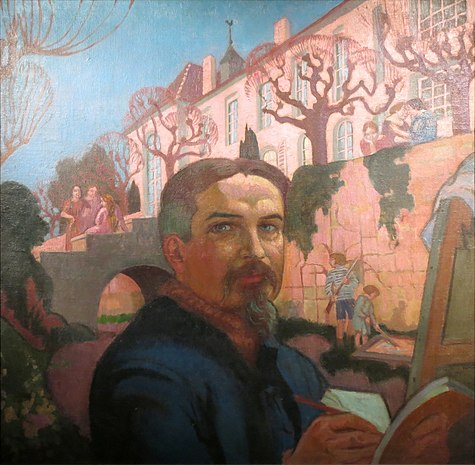



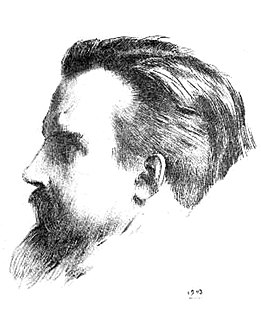






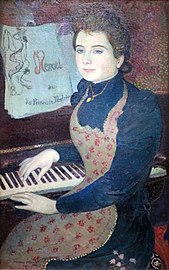



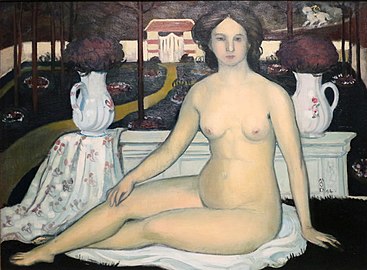

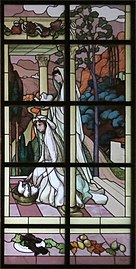



![Udsmykning: 'Korsets ophøjelse' og forherligelse af messen.[4]](http://upload.wikimedia.org/wikipedia/commons/thumb/e/ed/Maurice_denis%2C_decorazione_della_cappella_del_collegio_di_sinte-croix_du_v%C3%A9sinet%2C_esaltazione_della_croce_e_glorificazione_della_messa%2C_1899%2C_01.JPG/272px-Maurice_denis%2C_decorazione_della_cappella_del_collegio_di_sinte-croix_du_v%C3%A9sinet%2C_esaltazione_della_croce_e_glorificazione_della_messa%2C_1899%2C_01.JPG)



